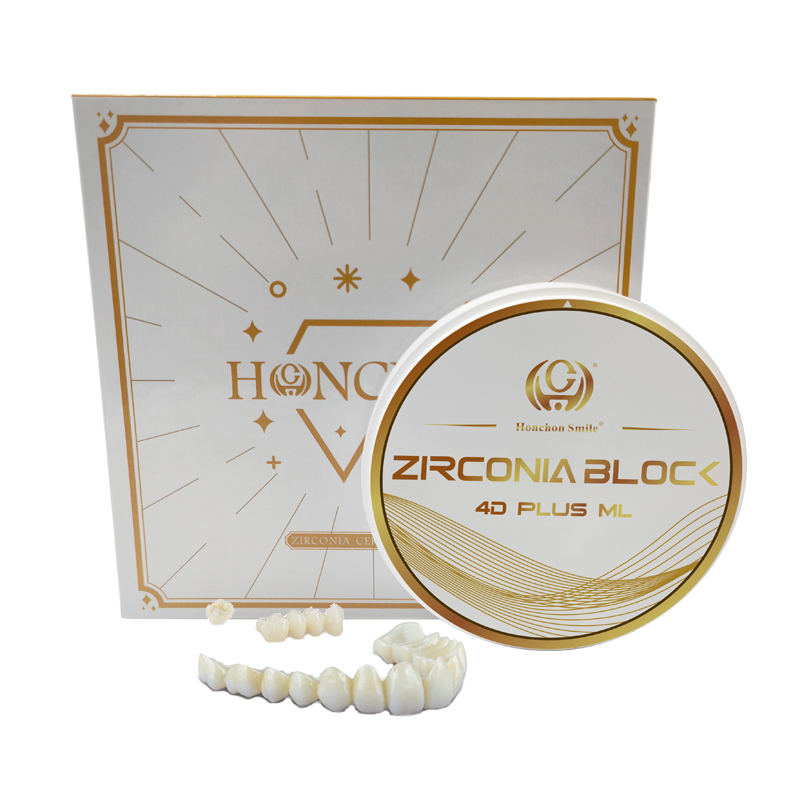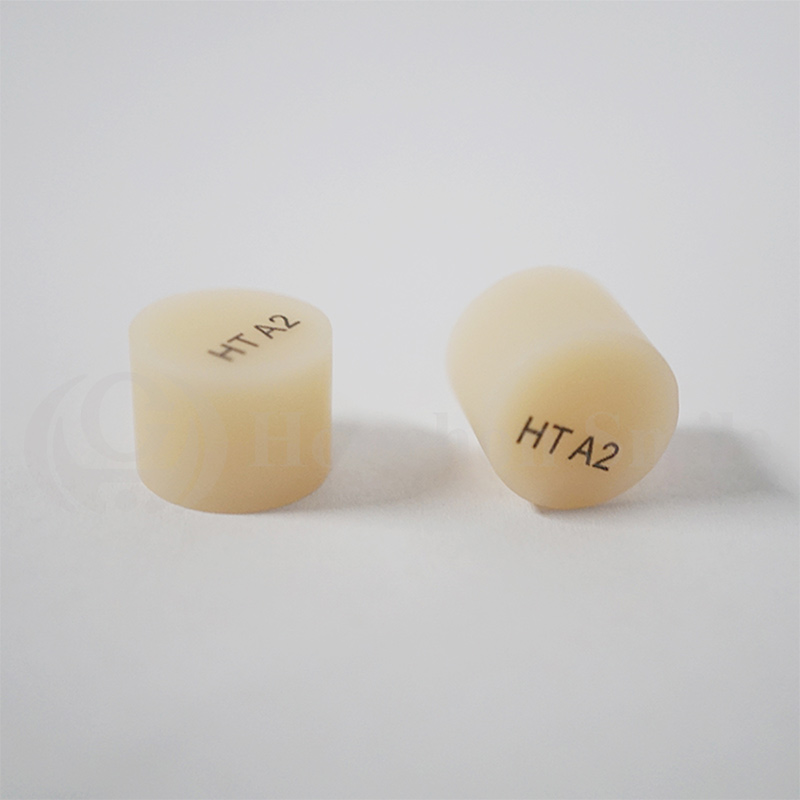What you must want to know about dental zirconia?
2024-04-10
1.what is dental zirconia block?
Dental zirconia blocks are crystalline oxide forms of ziriconia and contain metallic atoms in the crystal but are never considered to be metals. Since zirconia blocks are durable and biocompatible they can also be used in prosthetics and implanted in patients.
2.What is high translucent zirconia?
High translucent zirconias are made to remove impurities and structural defects. Among the differences in the manufacturing process are reduced alumina content and optimized distribution in an effort to maintain traditional zirconias' age-resistant quality.
3.Why zirconia is used in dentistry?
Zirconia is commonly a structural material used in dental bridge crown inserts and implants due to its biocompatibility, its high fracture resistances, and radiation protection properties.
4.Categories of dental zirconium blocks?
1. White zirconia block(ST HT UT SHT)
2. Color zirconia block (ST-C SHT-C)
3. Multi-layer zirconium block(UT-M SHT-M)
4. Multi-layer gradient zirconium block (3D plus 4D plus )
5.How is dental zirconia produced?
In industrial production, colored zirconia-based powder and white zirconia-based powder are usually mixed at different weight ratios by mixing the colored zirconia-based powder and white zirconia-based powder while changing the mixing ratio in order to express the desired Color gradient; Inject a variety of raw materials into the compression mold or mold frame in order of increasing or decreasing content of colored zirconia-based powder in the raw materials; and bake the molded product.
This makes it possible to express the beauty of natural teeth by achieving their color gradient within the zirconia block itself, without the need for porcelain powders or liquid color sets.
6.What Makes Zirconia So Strong?
The strength of ISO- and ADA-approved monolithic zirconia, a.k.a. Zirconium (IV) oxide, is derived from its tetragonal crystalline properties. When comparing it to glass ceramics and dental composites, zirconia is more split-resistant, stiffer, and stronger. Its strength can be both an asset and a drawback: you may face a challenge when removing a zirconia crown because of its tremendous strength. Trying to cut through a zirconia crown to create endodontic access can be quite challenging.
7.Why zirconia looks better now than ever?
The biggest problem with a full-contour monolithic zirconia crown is the opaque white appearance caused by structural defects that absorb light rather than allow it to pass through. This property is great for hiding discolored tooth structures or core buildups. But since it does not possess all of the translucent and refractory properties that would be desirable for a natural, lifelike appearance, its uses are limited to implant abutments, fabricating non-metal bridge frameworks, and restoring posterior teeth. How do you make zirconia suitable for aesthetically-pleasing anterior restorations? Now it is possible to fabricate zirconia restorations using layered, highly translucent zirconia formulations to create a look that blends with any neighboring tooth or restoration.
8.How are zirconia dentures made?
Zirconia is a durable and aesthetically pleasing material that can be used to provide patients with well-fitting prostheses. It is also a particularly ideal option for edentulous patients who wish to replace their entire dental arch. Outlined below is an overview of the manufacturing process, although the exact process may vary.
After taking a preliminary impression using an impression cap, the dental laboratory will create an initial working model that includes the soft tissue. Next, create the bite block with a temporary cylinder held in place by screws and a wax rim. These non-engaging temporary cylinders help ensure that the bite block does not move when used to record jaw relationships. Once the bite block is smoothed and finished, a notch or holding groove is created on the back surface. These grooves help improve the accuracy of bite recording by retaining the impression material against the bite.
Occlusal recording can be performed in a conventional manner, using cylindrical screws to hold the occlusal edges securely in place. The denture color and mold are chosen at this appointment. Once the clinician completes the bite registration and returns to the dental laboratory, the working model is mounted on the articulator and evaluated to ensure correct implant tracking or to make adjustments as needed. Full zirconia implant-retained restorations require approximately 10 mm of clearance. The next stage is to fit the patient with the prosthesis as a wax try-in. A wax try-in can be evaluated in the same way as a regular denture try-in. If adjustments are required, a new bite record should be made.
At this stage, the dental laboratory will also provide validation jigs and special custom trays. Verification clamps help ensure a passive fit and are fully sectioned and numbered so that each section can be secured to the appropriate implant. Once properly in place, the sections can be glued together with the appropriate material. The final impression is taken using a special custom tray mounted on a verification jig. The entire box is then sent back to the dental laboratory.
If the wax try-in is approved, the temporary prosthesis can be made and fitted and used as a temporary prosthesis. The temporary prosthesis is designed and manufactured using CAD/CAM technology and can be worn by patients for up to four weeks to evaluate its function and design. The final appointment is to install the permanent prosthesis, which is then screwed into place. It is best to cover the screws with cotton or other material before sealing the access hole with light-cured composite or acrylic. Manholes should be covered to prevent bacterial growth.
Patients usually need a follow-up visit after one week to check that the bite is perfect. Thereafter, they should follow a regular maintenance schedule that includes six-month hygiene appointments for preventive care under the prosthesis. The prosthesis should be removed annually for more thorough cleaning so that the condition of the screws can be assessed. Any that show signs of wear can be replaced at this time.
A complete zirconia implant-retained restoration requires a minimum of five dental appointments from start to finish. This number will be increased if modifications are required during the fitting phase. Despite the complexity of the procedure, the final restoration should be aesthetically pleasing and resistant to cracking, chipping, and staining.
9.How do you take care of zirconia dentures?
At-home cleanings for zirconia prosthesis can be performed similarly to traditional oral maintenance. Brush twice a day, use mouthwash as needed, and Waterpik any remaining debris. Zirconia is very durable and nearly impossible to break. This allows the patient more freedom as if they were their natural teeth.
10How long do zirconia dentures last?
These restorations are designed to last for life! Zirconia is an amazingly sturdy and durable material in dentistry. In fact, it's ten times stronger than the acrylic material used in traditional dentures. It's as resilient as a titanium implant, meaning it will support your smile for life.
11.How do you maintain a zirconia bridge?
Opt for an antimicrobial or fluoride mouthwash to reduce bacteria and strengthen your teeth. Flossing is also important. Clean between the fake teeth and beneath the bridge with a floss threader, interdental brush, or an oral irrigator. Using a waterpik is also a highly efficient method.
12.What are the disadvantages of zirconia teeth?
While zirconia is a highly durable material, its hardness can lead to increased wear on the teeth that come into contact with it. In some cases, zirconia crowns may cause more wear on the opposing natural teeth or restorations over time. However, the use of an occlusal splint can effectively prevent this wear.




